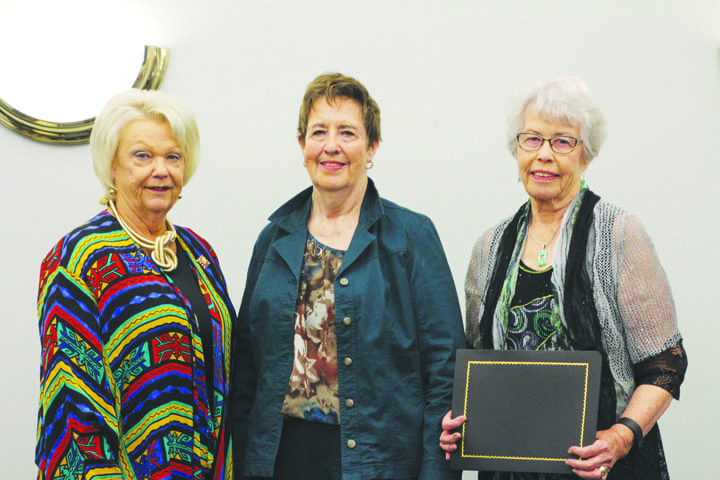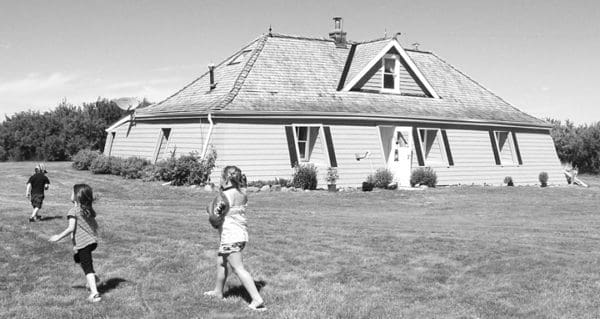
Lenore McTaggart of Saskatoon (centre) and Shirley Kuchar (right) of Kindersley, who are both granddaughters of sod house builder James Addison, accept a Lieutenant Governor’s Heritage Award from former lieutenant governor Vaughn Solomon Schofield on June 14, 2017, at Government House in Regina. The historic sod house property had its provincial heritage property designation revoked in July.
Kenneth Brown
of The Crossroads
The Addison Sod House is no longer a provincial heritage property because the historic property’s current owner asked to have the designation revoked.
A Revocation Order of the Provincial Heritage Property status was made on July 11. Gene Makowsky, the minister of Parks, Culture and Sport, made the revocation order of the property’s designation. The sod house was designated on Nov. 23, 1992 under the Heritage Property Act.
Descendents of the Addison family expressed an interest to offload the property to another group to own and operate. James Addison built the sod house between 1909 to 1911, and it was designated as a provincial heritage property and a national historic site. The property remains a national historic site.
[emember_protected for=”2″ custom_msg=’For more on this story, please see this week’s print edition of The Cross Roads.’]
A grassroots group known as Friends of Addison Sod House (FASH) was established through late 2016 and early 2017 with hopes of helping to find a solution. The FASH group hoped to find new uses or owners for the property and fundraising was part of the plan.
There are structural concerns at the sod house, so FASH had provincial officials go to the property and the group received a site observation report. Several recommendations were made regarding drainage and structural concerns.
Two employees of the Town of Kindersley were helping to facilitate the FASH group by providing their leadership and expertise, but neither employee is still working for the town. As a result, the FASH group fizzled out before a solution was found and the Addison family is no longer able to maintain or care for the site.
The plan at one time was to raise funds to hire a special structural engineer from New Brunswick to do a complete assessment of the site, but it was going to cost about $30,000. There was a meeting in May 2017, and then it was done.
Marvin Thomas, the heritage planning and policy advisor for the ministry of parks, culture and sport, said the ministry helped to facilitate some of the initial meetings with interest groups. He said he attended the group’s first meeting in June 2016.
He said there is no requirement for the province to provide any notice of the revocation if the request is made by a property owner. However, the province does publish a notice of the revocation order as per the legislation under the Heritage Property Act, but notice does not have to go out for the intent to revoke the designation. The property owner cited personal reasons for the request and it is an unfortunate reality.
“It’s not a desired outcome,” he said, adding that the owner, province and people involved in the FASH group made their best efforts over time to find a solution and it was not found. “The main problem is just identifying and implementing a viable use for the property.”
Thomas said a heritage property designation is viewed as a working partnership between the province and the property owner. He recognized that the order came in a subsequent generation of the Addison family and circumstances change in time. The loss of a heritage designation does not close the door to finding a future use and preservation, but it frees up options for the property owner, he added.
Parks Canada is responsible for designating national historic sites. The Addison Sod House was designated as a national historic site in 2004. The status remains in place, but it does little to help preserve the site, according to Parks Canada.
The federal designation is only for commemorative purposes, so it would not provide for the protection of historic sites that are not administered by Parks Canada. The protection of a heritage property not owned by the federal government is the responsibility of each provincial or territorial government, so legislation is set by the provinces and territories in the case of heritage protection.
Mayor Rod Perkins of Kindersley said he once met with Lenore McTaggart, the current property owner, and he was told she is giving up the property due to various personal circumstances.
The property is located in the Rural Municipality of Oakdale across a road from the RM of Kindersley. Perkins said it is unfortunate that the history could be lost, but the last report he received did not give him very much confidence that the structure could be saved.
“It’s way too far gone to do anything,” the mayor said, recognizing that he heard it could cost in excess of $100,000 to perform remediation to the sod structure and the remediation is not likely to work. “There’s no funding available for it.”
McTaggart, a granddaughter of James Addison, said she is getting older and she has back issues, so she is no longer able to care for the property or building. She said her children are busy with work and other commitments, so they do not have the time or money to commit to the property.
She noted that her children are interested in the heritage of the property, but they just cannot to commit to it. She noted that she was hoping for a community-led solution, but it did not come to fruition. She has no plans to sell the house.
“I’m going to keep the land and as far as where the house is placed, I haven’t got any plans,” McTaggart added, recognizing that she would be willing to subdivide and sell the property for next to nothing if the right offer was made to ensure the preservation of the house and its surroundings.
Bill Warrington, chairperson of the Kindersley & District Plains Museum, is a resident of the Loverna area and a local historian. He was attending the FASH meetings and he said it will be disappointing if the building is lost.
The historian said he knows of several historic properties that were bulldozed and turned into cropland, but he believes it is unlikely a person with enough money will come forward to save the building. He added that the history could be preserved by the museum, but the historic structure could be lost and “that’s breaking my heart.”

